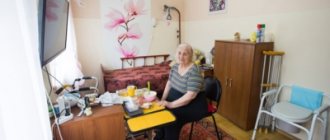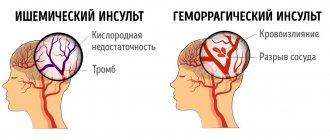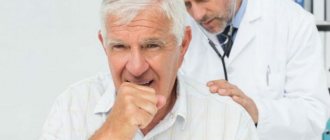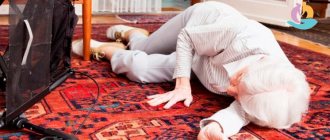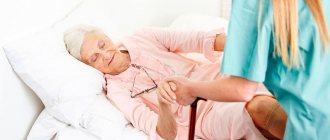1
Author of the article: Marina Dmitrievna
2017.11.01
4 543
Vessels
The leading cause of death in old age today is stroke. This disease is a disruption of the blood supply to areas of the brain, which leads to their death. Depending on the affected areas of the gray matter, certain functions are impaired in a person.
Brain after stroke
Most often, a patient after a stroke cannot swallow, move (fully or partially), speak clearly and coherently, or take care of himself hygienically. And only after long-term rehabilitation with outside help (relatives or professional caregivers) abilities return in full or incomplete, which depends on the degree and size of brain damage.
Causes
After a stroke, the patient is recommended to undergo an examination, which will provide an opportunity to determine swallowing disorders during a stroke. In the presence of specialists, the patient should take a trial meal, which will provide an opportunity to determine the degree of the disorder. During the examination of the patient, it is recommended to identify accompanying symptoms.
The swallowing reflex is impaired if the patient chokes while eating or drinking. The patient may complain of a feeling of food stuck in the throat. The patient eats and drinks drinks very slowly . At the same time, he needs to make great efforts. Swallowing is impaired if a person loses food and leaks liquid while eating and drinking.
During meals, gurgling sounds occur. Since a person cannot swallow fully, food remains in that part of the oral cavity that is characterized by a lack of sensitivity. After eating, patients experience a sensation of a lump in the throat. So they try to clean it up. During the period of taking liquid food or drinks, they flow from the nose.
The symptoms of dysphagia after a stroke are pronounced, which allows the patient and his family to determine it independently. When the first signs of the disease appear, the patient is recommended to consult a specialist who, after carrying out appropriate diagnostics, will determine what to do in a particular case.
Definition of stroke and dysphagia
Ischemic stroke is necrosis of a region of the brain that occurs as a result of insufficient blood supply, and hence oxygen starvation. This happens due to blockage of the lumen of blood vessels with cholesterol plaques or their sharp narrowing (spasm). Hemorrhagic stroke is a consequence of hemorrhage from a vessel into the brain parenchyma caused by its rupture.
Ischemic stroke
The vast majority of patients after a stroke have disorders of swallowing, chewing and sucking functions. This is due to the fact that to be able to swallow, many muscles sequentially contract, ensuring the safe movement of the bolus of food through the oropharynx. And this process is coordinated by several areas of the brain:
- First, food is moved by the tongue to the back of the oral cavity, for which the XII cranial nerve is responsible;
- Contact of the food bolus with the posterior wall of the oropharynx triggers the mechanism of closing the entrance to the trachea (leading to the lungs) and further movement of food using the IX and X cranial nerves;
- Next, the cricopharyngeal sphincter opens, the food bolus moves through it and further moves along the esophagus into the stomach, which provides a special swallowing center located in the medulla oblongata.
Video about the anatomical features of the swallowing function:
Important! When the swallowing center is damaged after a stroke, as a rule, the adjacent areas of the reticular formation, which interact with the respiratory and other centers, are affected.
Thus, difficulty swallowing food in medicine is called dysphagia. Depending on the severity of the stroke, it has different manifestations:
- A single stroke of the cortex or subcortical areas (damage to a small area locally) leads to the manifestation of dysphagia within the first seven days. Moreover, in most cases, patients completely restore swallowing function after 20 days;
- With a brainstem stroke, the development of dysphagia is more likely. And to recover from lateral medulla oblongata syndrome, intensive corrective therapy for swallowing is necessary;
- After multiple strokes, dysphagia is more pronounced and requires more rehabilitation measures. Resumption of swallowing function in such patients takes a long time and does not completely restore the possibility of oral nutrition.
Brain after a hemorrhagic stroke
But for any course of the disease, it is very important to know how to feed a patient after a stroke with a swallowing disorder. If you do not help a person cope with dysphagia or violate certain feeding rules, there is a likely risk of developing complications of this pathology.
Diagnostic measures
If symptoms of pathology occur, the patient is recommended to be examined by a doctor. The specialist conducts a trial feeding of the patient, which allows him to determine the symptoms of the disease and make a preliminary diagnosis.
To confirm it, it is recommended to use additional diagnostic techniques:
- Videofluroscopy, which is the most informative for dysphagia.
- Electromyography.
- Pharyngeal or esrophageal manometry;
- Pulse oximetry;
- Fiberoptic endoscopic assessment of the swallowing reflex.
Diagnosis of the pathological condition must be comprehensive, which will allow the doctor to determine the extent of the disorder and prescribe effective treatment.
Methods for restoring swallowing function
Restoration of swallowing is carried out in two directions:
- Compensatory techniques - learning the correct position of the body and head during swallowing.
- Developing a group of muscles involved in swallowing. A special set of exercises necessary to restore mobility, as well as various types of sensitivity in the mouth and larynx.
Doing all the exercises will only bring results if they are done regularly.
No less pressing is the question of whether it is possible, when feeding through a nasogastric tube, to restore the ability to perform the swallowing reflex, because if there is no stimulation, then there can be no talk of any rehabilitation - the apparatus responsible for swallowing is simply not receives the required load.
But in reality, everything is somewhat different - a kind of subconscious memory is embedded in the human body at the genetic level, and the rehabilitation of lost unconditioned reflexes largely occurs on its own, without any outside stimulation.
The reflex arc, being quite complex and multi-stage, gradually restores its activity. Of course, this process becomes possible only if the surviving neurocells of the brain take over the functions of the necrotic regulatory centers. It is clear that if work is carried out with the patient, rehabilitation of the swallowing reflex will take place much faster.
Features of feeding
In case of dysphagia, it is recommended to feed the patient properly, which will eliminate the possibility of complications. Patients are strictly prohibited from consuming solid and liquid foods at the same time. In order to eliminate the possibility of food entering the respiratory system, the patient is initially given thick food.
If a decision is made to feed the patient liquid food and drinks, then he is initially given yogurts, jelly, and fermented baked milk. Thanks to their special consistency, the time until the next sip is increased. It is recommended to give ordinary liquid drinks to the patient after the swallowing reflex is completely restored.
Patients are strictly prohibited from eating food that contains liquid fiber. Eating food with a dry, crumbly texture is also not recommended. After a relative or loved one has fed the patient, he should examine his oral cavity. If food remains in the mouth, it must be removed. After eating, it is recommended to perform oral hygiene .
It is strictly forbidden to rush the patient while eating, as this can lead to nervous disorders. The patient can eat one serving of soup for about 60 minutes. Eating while lying down is strictly prohibited. Before eating, the patient should be seated or provided with a semi-sitting position.
Recovery after a stroke requires ensuring proper feeding of the patient. To this end, relatives and friends must adhere to the above rules.
What tests are required for dysphagia?
If a person is in a condition, there are opportunities to conduct examinations and determine the characteristics of the health condition. Moreover, the situation is easier if the victim can remain in a sitting position. The nurse may suggest drinking a small amount of water. So, the main task is to swallow water one teaspoon at a time .
If a person can swallow the suggested amount of plain water painlessly and without coughing or choking, one can count on a favorable result. The test can be repeated until the person drinks a small glass of water on his own. The achieved result will confirm the successful treatment of dysphagia and restoration of impaired functions.
If the problem persists, your doctor may do other tests. The main task is to fully assess the health status of a person suffering from a stroke. Among the possible examination options is video fluoroscopy, which involves the patient swallowing a small volume of liquid containing barium. It is assumed that barium will highlight on the x-ray the correct place where disturbances occur during swallowing movements.
Correct diagnostics will allow you to determine the cause of the violations in order to try to eliminate the problem, despite its presence.
Using the probe
A gastric tube is a special device designed for feeding a person, which is used in the complete absence of a swallowing reflex. It is installed for a long period (3-4 months). A new tube is replaced three weeks after installation of the probe. A new portion of food is introduced with a Janet syringe or a special system that provides drip enteral nutrition.
It is recommended to feed the patient through a tube for the first time in a hospital setting . The patient is discharged with the probe already installed. This will allow the person to be restored at home. Thanks to the presence of this device, the rehabilitation period is greatly simplified. Medicines prescribed by the doctor are also given to the patient through a tube, which ensures that their active substances enter the body.
If, when using a probe, patients are diagnosed with a peristalsis disorder, this will negatively affect the patient’s recovery after a stroke. In this case, the patient is given a gastrotomy. This is a special installation that connects the stomach and the environment. The introduction of liquid food is carried out through the external opening.
Caring for a gastrotomy is quite complex. In addition, there is a risk of developing an infectious process. That is why, when using the device, it is recommended to strictly adhere to the doctor’s recommendations. The use of a tube or gastrotomy ensures adequate nutrition for the patient after a stroke, which contributes to a speedy recovery.
Exercises
Five months after the stroke, the difficulty with swallowing had decreased, but remained. We told the speech therapist about this. The doctor recommended doing special exercises and selected exercises for me. We started doing swallowing exercises every other day, in the late afternoon.
Drawing syllable
- I take a deep breath.
- I hold the tip of my tongue with my teeth (lightly, without injuring, not too much). I pronounce the syllable: NNNNNNAAAAAAA. I stretch out the sound as long as possible while I have enough air. While pronouncing the sound, I do not let go of my tongue and continue to hold it.
- 10 reps.
Saliva
- swallowing movements" (without food and without liquid): Inhale, hold your breath, swallow saliva and, without exhaling, cough two or three times (while holding your breath).
- 5 reps.
Language
- I move my tongue as far into my mouth as possible and hold it in this position for 1 second. Then I relax my tongue. I return to normal position.
- 5 reps.
A sip
- I take a sip (without food and without liquid). I take a sip with effort. But I don’t take it all the way, in the upper position of lifting the “Adam’s apple” (Adam’s apple), I linger for 2 seconds and then take a sip. I perform the exercise with effort.
- 5 reps.
Vowel sounds
- I pronounce the sounds “A”, “O”, “U”, “Y” in turn. I pronounce sounds with effort and pressure.
- 10 reps.
These exercises restore the functioning of the swallowing muscles.
It took about four months to learn to swallow again. The result is very good. At the moment there are practically no problems with swallowing. In addition to swallowing, gymnastics helped improve speech and partially established proper breathing during conversation.
Swallowing rules
In addition to gymnastics, we came up with several rules and follow them. They help overcome difficulty swallowing:
- I drink in small sips. Calm and smooth.
- I don’t eat in large pieces, I bite off the next piece only after I have chewed and swallowed the previous one completely.
- I don’t get distracted or talk while eating or drinking.
- We make sure that food and drink are not hot.
Restoring lost body skills after a stroke often has to be done simultaneously using several methods. This gives a really effective result and speeds up recovery. But I’m still far from Nikolai Yakovlevich Bogdanov)))
Rehabilitation methods
Restoring the swallowing process requires the use of several techniques. Initially, a compensatory technique is used. The patient is taught to correctly position the head and body while eating. The patient must develop a group of muscles that are involved in the swallowing process.
To do this, the patient is recommended to perform special gymnastics, which allows you to restore muscle mobility, as well as sensitivity of the oral cavity and larynx.
The patient must perform each exercise under the supervision of a specialist, which will have a positive effect on the result. The complex is developed only by a specialist after examining the patient in accordance with the severity of the pathological process. In order for the exercises to be highly effective, it is recommended to perform them regularly.
The set of exercises is aimed at developing the cheeks, palate and tongue. In most cases, patients are recommended to perform the standard complex:
- The patient is advised to puff out his cheeks and hold them for 15 seconds. After this we return to the starting position. The manipulation is repeated 5-7 times in one approach.
- The next step is to raise the tip of your tongue to the roof of your mouth. In this case, the mouth must be closed. After returning to the original position, open your mouth and raise the tip of your tongue again.
- The patient should regularly imitate swallowing movements.
- The next exercise is to pronounce the sound “y”. In this case, the lower jaw should move forward.
- At the next stage, the patient should open his mouth wide, as when yawning.
- Next, close your mouth and make the sound “m”.
- If the swallowing reflex is impaired, rinsing the mouth is recommended.
Each exercise should be performed in several approaches. The frequency of repetition of manipulations is from 6 to 9 times . If possible, the number of repetitions is regularly increased.
It is forbidden to force a patient to perform manipulations that he cannot perform. Initially, he is recommended to perform several exercises at a specified interval. If he fully copes with this task, then you need to add one exercise. It is recommended to repeat this until the patient performs the full complex.
Gymnastics should be carried out until the swallowing reflex is completely restored. To increase the effectiveness of exercises, patients are prescribed physiotherapy procedures, which involve exposure to current.
To combat the pathological process, the patient is recommended to undergo drug treatment. Proton pump inhibitors are recommended for the patient. The drugs are highly effective in patients with high acidity. If a bacterial infection occurs in parallel, then the use of drugs with antibacterial action is recommended . If conservative therapy is ineffective, surgical intervention is recommended.
Treatment of dysphagia should be comprehensive. The choice of methods is carried out by the doctor after a complete examination of the patient, which will restore the swallowing reflex as soon as possible.
What signs of dysphagia should you look for?
Dysphagia manifests itself not only in difficulties with swallowing movements, but also in other unfavorable changes.
- Drooping of the oral cavity.
- Gurgling.
- Slurred speech.
- Constant feeling of discomfort in the throat.
- Cough.
- Suffocation.
In most cases, dysphagia resolves within a few weeks. However, some people have to spend a long time restoring a full swallowing reflex. A small number of people who have a stroke do not regain their ability to swallow.
Complications
The inability to swallow leads to a decrease in the patient's quality of life. After a stroke, a large number of patients lose the ability to swallow even liquid food. With careful and long-term treatment, the prognosis will be positive. Otherwise, patients may experience complications.
The patient eats food for a long time and inattentively, which leads to poor-quality intake of nutrients. Against this background, the patient is diagnosed with a sharp weight loss. In some cases, dehydration may be diagnosed. This is a serious complication that can be fatal.
With dysphagia, the patient often chokes and coughs. In some cases, pieces of food may enter the respiratory tract. This leads to complications that are infectious in nature. In severe cases, aspiration pneumonia develops. Patients experience a paroxysmal cough. If the pathological process is not treated in a timely manner, pneumonia develops.
If the prognosis is favorable, then restoration of the swallowing reflex is observed 20-30 days after the stroke attack. With significant violations, the duration of the recovery period increases significantly. Sometimes patients experience a decrease in swallowing problems. But, they remain for life.
In accordance with the studies, it was found that with adequate therapy, the swallowing reflex is restored in 95 percent of patients . This is explained by the fact that after a stroke, the body’s forces are redistributed in such a way as to first restore vital functions.
Brain stroke belongs to the category of dangerous diseases, which causes disruption of various functions in the body. With extensive brain damage, disturbances in the process of swallowing food are diagnosed. The pathological process is accompanied by pronounced symptoms, in the event of which a comprehensive diagnosis is recommended. It allows you to determine the extent of damage. In accordance with this, the doctor selects treatment methods. To restore the reflex, drug therapy, gymnastics, and proper nutrition of the patient are used.
Swallowing problems after stroke: causes, methods of diagnosis and treatment
Dysphagia, or difficulty swallowing, is one of the most common complications of stroke. According to statistics, it occurs in 20-60% of patients. Manifestations of dysphagia depend on its degree.
With mild symptoms, the patient experiences discomfort associated with food retention and difficulty swallowing certain foods, such as liquids or solid foods.
In severe dysphagia, the ability to swallow is completely absent.
Next, we will list the causes and symptoms of swallowing problems after a stroke, talk about the dangers of health complications, and provide recommendations for treatment.
Swallowing: normal and abnormal
In a healthy person, the swallowing process occurs in several stages:
- preparatory oral phase - grinding food, forming a food bolus;
- oral propulsive phase - moving a bolus of food into the pharynx using the tongue, beginning to swallow;
- pharyngeal phase - movement of food from the pharynx into the esophagus due to movements of the tongue and pharyngeal structures;
- esophageal phase - the movement of food through the esophagus to the stomach due to contraction of the muscles of the esophagus.
With dysphagia, difficulties can occur at any of the described stages, but most often occur in the pharyngeal phase.
Symptoms of impaired swallowing
Dysphagia should be suspected if the following symptoms occur:
- the patient chokes on food or coughs while eating;
- drops food from the mouth or experiences discomfort when it gets stuck behind the cheek;
- eats slowly, makes effort;
- has difficulty swallowing tablets or water;
- complains of heartburn, food getting stuck in the throat;
- in severe cases, he refuses to eat or drink at all.
Causes of dysphagia
Most often, dysphagia develops in patients who have suffered ischemic hemorrhage in the brainstem. With this course of stroke, damage occurs to the nuclei of the glossopharyngeal and vagus nerves, and sometimes to the hypoglossal nerve.
After damage to these structures, flaccid paralysis of the muscles of the tongue, soft palate, epiglottis and pharynx develops. As a result, the patient experiences discomfort, difficulty, or cannot swallow food and water at all.
What are the dangers of impaired swallowing after a stroke?
Dysphagia can cause a serious and life-threatening condition called aspiration. During aspiration, food particles and other foreign bodies enter the respiratory tract below the level of the ligaments. A pathological condition should be suspected if:
- the patient complains of difficulty swallowing;
- speaks quietly or in a hoarse voice;
- coughs during and after swallowing, coughs frequently throughout the day, clears throat at the beginning of a conversation.
Aspiration is dangerous because it can cause suffocation and pneumonia. Patients after a stroke suffer severely from pneumonia. The body, weakened after the blow, cannot cope with the disease for a long time; in severe cases, death occurs.
Doctors have not learned how to eliminate dysphagia with medication. Therefore, to correct the disorder, physiotherapeutic procedures are carried out and nutrition is adjusted.
Physiotherapy
Swallowing disorders are treated with physiotherapeutic methods. The doctor prescribes to the patient:
- Transcutaneous electrical stimulation. The essence of the method is the application of weak electrical impulses through electrodes that are placed on the skin. The impulses stimulate the swallowing muscles and help restore their function.
- Transcranial magnetic stimulation. During the procedure, magnetic pulses are applied to the patient's brain. Sessions are repeated daily for 5 days.
Nutrition correction
In the acute period of a stroke, the patient is given parenteral nutrition - nutrients are administered through infusions, bypassing the gastrointestinal tract. When the patient’s condition returns to normal, he is transferred to his usual diet. The only exceptions are cases of severe dysphagia, when a person is completely unable to swallow.
Before discharge, the patient’s relatives are taught how to feed him correctly:
- encourage a person if he wants to eat on his own, and help only if necessary;
- When eating, ensure a calm environment and try to eliminate distractions;
- help the person find a comfortable position: sitting, so that the torso is at an angle of 90 degrees to the chair, and the neck is slightly bent;
- use special dishes, for example, a cup with a spout, feed only from a metal teaspoon;
- make sure the patient has swallowed food before giving him more food or water;
- monitor your condition for half an hour after eating;
- Be sure to perform oral hygiene after every meal.
If a patient has difficulty swallowing solid foods, doctors recommend including purees and thick liquids, such as soups, in the diet. It is important to ensure that the diet is complete and varied.
Sources
- “Post-stroke dysphagia”, Schneider N.A., Bakhtina E.A., Bulletin of the Clinical Hospital No. 51, 2008;
- “Swallowing disorders after stroke”, Gromova D.O., Zakharov V.V.
, Neurology, neuropsychiatry, psychosomatics, 2015; - “Swallowing disorders in strokes. 3. Features of managing a patient with dysphagia,” Sorokin Yu.N., Emergency Medicine, 2015.
Diagnostic accuracy and quality service are the main priorities of our work. We value every review our patients leave us.
Panina Valentina Viktorovna
Actress, Honored Artist of the RSFSR
I found out about you on the Internet - I urgently need an MRI.
And after the performance I’m with you. I really liked your staff. Thank you for your attention, kindness and accuracy.
May everything be as good in your soul as I am now, despite all the problems...
Be!!! We're happy! Your Panina V.V.
Open review scan
Array( [ID] => 107 [~ID] => 107 [CODE] => [~CODE] => [XML_ID] => 107 [~XML_ID] => 107 [NAME] => Panina Valentina Viktorovna [~NAME ] => Panina Valentina Viktorovna [TAGS] => [~TAGS] => [SORT] => 100 [~SORT] => 100 [PREVIEW_TEXT] =>
I found out about you on the Internet - I urgently need an MRI.
And after the performance I’m with you. I really liked your staff. Thank you for your attention, kindness and accuracy.
May everything be as good in your soul as I am now, despite all the problems...
Be!!! We're happy! Your Panina V.V.
[~PREVIEW_TEXT] =>
I found out about you on the Internet - I urgently need an MRI.
And after the performance I’m with you. I really liked your staff. Thank you for your attention, kindness and accuracy.
May everything be as good in your soul as I am now, despite all the problems...
Be!!! We're happy! Your Panina V.V.
Source: https://cmrt.ru/simptomy/narushenie-glotaniya-posle-insulta/
